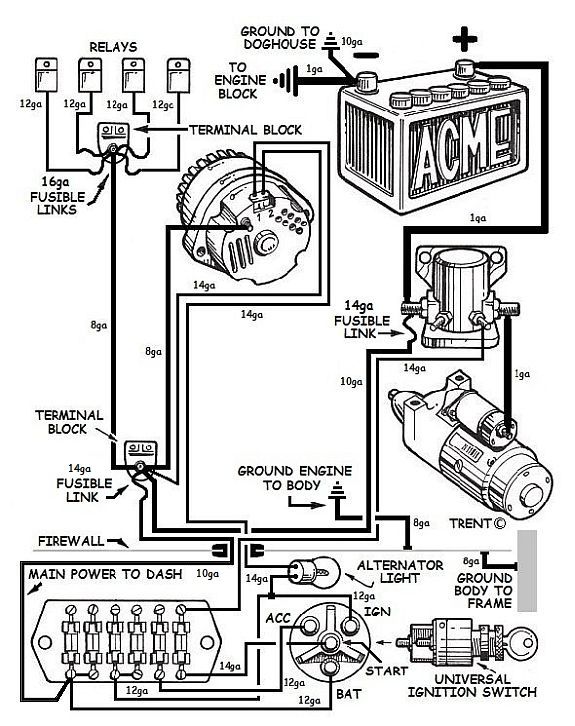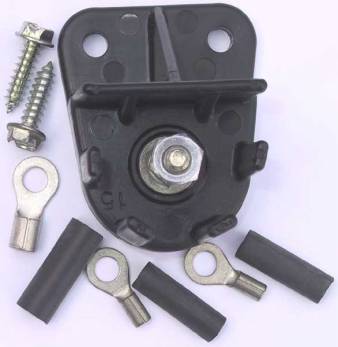|
Impoved Power Circuit! How to Fix a Weak or Overloaded Electrical SystemOk, let's talk about your power circuit. Power circuits are the part of your electrical system that generates power and then supplies that power to your system. Making this part of your electrical system work is the most important place to start! If you have an older car, you probably need to improve your power circuit. Most cars were manufactured with the bare minimum as far as wire gauge size to reduce costs in manufacturing. (Copper is expensive...) Some were also not designed very well. They were overly long, going through many switches and connections before finally getting to the unit. Voltage drop was present before ever even getting to a particular unit. Now, you want to add better ignition systems, accessories, electric fuel pumps, etc. that all need a full 12 volts to operate right. See the problem? The original wiring systems were made to just handle the requirements of the day. Remember, if you have changed over to an HEI or any non-points distributor, you're more than likely getting the power from ignition at the fuse block. It has to have a full 12 volts to run right. If you try to run the headlights without relays, you're pulling all that power from the dash too. The dash is usually fed by a single 12ga wire. It's often long, so there is already a voltage drop. So, you may not get a full 12 volts to the HEI, or to the headlights. Now, add on an electric fuel pump powered from the fuse panel... See where we're going with this? Now you have dim headlights, a weak ignition system, and you are going to burn up your electric fuel pump (they don't like low voltage). And that's just those three circuits. You have much more attached to dash power.If you upgrade or add anything to an older car, you need to also upgrade your electrical system. Namely, your power circuit. Well, let's take care of that... Don't worry, it's not hard... First, let's understand what's going on... Many people think that the battery supplies all the power for the car when it's running and the alternator simply is there for charging it back up. Actually, it's the other way around... The battery is there to start the car, and the alternator is there to not only charge the battery, but to supply the car with electricity while it's running... That's why you want to pull power for a circuit from near the alternator (or generator). For example: In my wife's '68 Camaro, the original path for power to get to the fuse panel was almost 12 feet long and went through 6 different connections that were over 40 years old with wire that was barely big enough for the system then. So I changed to an improved power circuit. Now that same power circuit is about 4 feet long with 3 connections and much bigger wire. It was also easy to do. There is plenty of voltage, and lots of power to handle upgraded ignition, accessories, etc. A small voltage drop in wiring will cause a major loss of performance. The original factory system had enough voltage drop problems in wiring to the dash area. Weak voltage levels will result with weak performance! This improved power circuit has many advantages over the original system. It improves overall performance, including better voltage at the dash area. It also fits in with battery relocation. And this improved power circuit can handle more powerful alternators than the original wiring system. Read more about the improved power circuit here:
Improved electrical system
1. Use an internally regulated alternator (3-wire) Delco 10SI. While not totally necessary, it makes things so much easier and simpler. This eliminates lots of wire and complexity. It's easy to wire in, but you can also get an alternator wiring kit from MAD or other manufacturers with instructions and everything you need.
2. Use a power distribution block on the firewall. This way you can tie directly into the alternator power for the dash. Otherwise you have to go back and forth in the engine bay, running through connections and losing voltage until you finally get back to the dash. Here's a nice one from MAD: Power distribution block
This is also where you want to run your #2 wire from the alternator. You want the signal wire for a three wire alternator (the #2 wire) to connect to this point to read how much voltage the alternator needs to put out, since this is the point where all the power is drawn from. If you just put the #2 wire from the alternator back to the Bat terminal on the alternator, it will work, but it won't read the voltage that's needed moment to moment. It can cause the alternator to not put out enough voltage when it's needed. 3. Use a power distribution block on the core support at the front of the car, unless you have a horn relay with a buss bar. This way you have a good place to draw power to run relays for headlights. That's why you need relays nowadays... All modern cars have them. That's because ignition systems are more powerful, headlights need more power, etc. Basically, what you are doing with relays is supplying a short cut for the power. Instead of the power having to go through all kinds of connections, switches, tons of wire, etc., you create a short path for it to go, free of all that other stuff. Now you have lots of power and full voltage. 4. Although it's not required, adding a remote starter solenoid (like a Ford) has many benefits. This was started by drag racers years ago... First, it shortens your power circuit. You don't have to run it clear down around the engine to the starter and back up, and it keeps it away from the heat. Second, the only time your positive battery cable is live down around the engine and exhaust manifold or headers is at startup. Third, it's so much easier to work on and to connect wiring to than trying to do it under the engine at the starter. Forth, it eliminates "hot start" problems. There are other benefits, but you get the idea. Just get a Ford starter solenoid, (for instance, one for a '66 Mustang), and don't forget to add a heavy jumper wire or piece of copper between the Bat post on the starter and the S (start) post on the starter. Or, simply buy a kit from MAD or other manufacturers. They have instructions and everything you need. Like I said, not everything is required. Not every electrical system is the same, and you may discover that yours is ok. However, if you're not good at diagnosing electrical systems, and you want more performance and reliability, this is an easy way to go. Especially if you are fixing or modifying your wiring or starting from scratch. Return from Improved Power Circuit to Hot Rod Wiring
|


